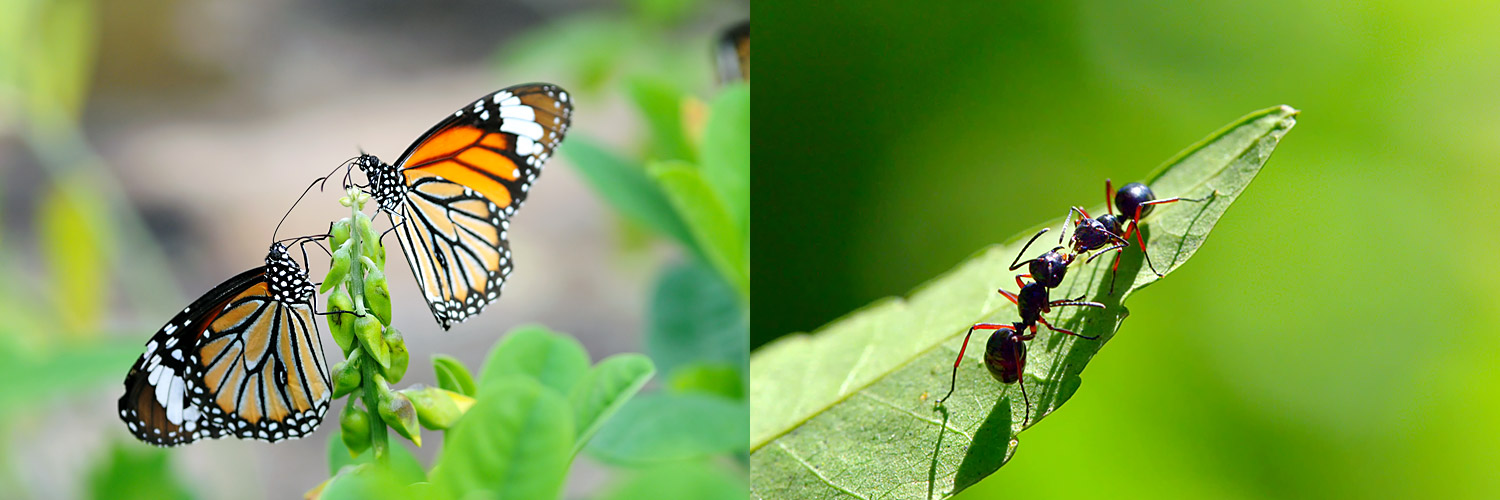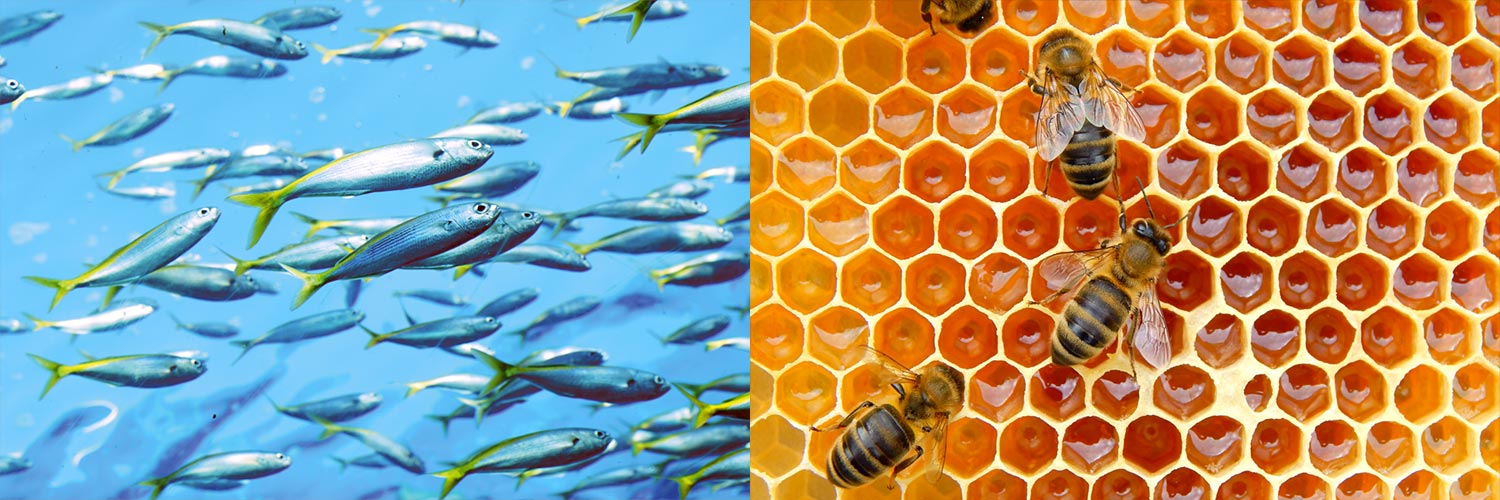How do animals see, hear, and feel the world? It is very difficult to imagine the world of animals on the basis of our senses. It is because various animals on the planet sense the world in different ways than humans do. For animals, their own unique world created by their special sensory organs spreads before them. Let’s take a trip to the wonderful world of animal senses.
Sensory organs that feel the world more accurately: vision, hearing, smell

Regarding sharp-sighted people, we say that they have eyes like a hawk. In fact, birds of prey such as hawks and eagles have extraordinary vision which enables them to see 4 to 8 times farther than the average human can. Hawks have 5 times as many visual cells as humans, and they have two maculae, which enable them to see a wider view more accurately. For example, the American Kestrel from the family Falconidae is believed to be able to find a 2 millimeter [0.08 inch]-long caterpillar crawling on the ground while sitting on an 18-meter [59 ft]-tall tree.
Although the hawk’s sight is so sharp, it has a disadvantage. When the sun sets, it becomes almost blind. This is because it has almost no rod cells which function in the dark. On the other hand, the retina of an owl, which is called a night hunter, consists mostly of rod cells, so its night vision is 3 to 10 times better than humans.
Many animals, including birds and insects, see ultraviolet and infrared light which humans cannot see. The caterpillar which has a protective color stands out to the birds that can see ultraviolet rays, and the urine of the vole appears as fluorescent. This makes it easy to find a hideout of a vole. Many flowering plants have patterns that are visible only in the ultraviolet range, pointing to the center of the flower. Insects look at this sign and locate where honey is with pinpoint accuracy. Snakes have holes called pit organs on their faces between their eyes and nostrils, which can detect infrared radiation. With this organ, they can sense the body temperatures of animals, and this makes it easier for them to hunt even in the dark.
Snakes also have extraordinary olfactory organs. You often see snakes flicking their forked tongues. This is an act of sensing smell scattered in the air, which is similar to flaring the nose. This is because snakes insert the odorant molecules attached to the tongue into the olfactory organ known as the Jacobson’s organ which is located on the roof of the mouth. The Jacobson’s organ is a pair—one on the left and the other on the right, so snakes can respectively feel the smell molecules that are at the tip of its tongue split apart, and find the direction of the smell through the difference of molecular weight detected at the tip of the tongue on the left and on the right.

In the case of insects, they can smell very well because half of their brain cells are mobilized for the sense of smell. The male butterfly smells the pheromone secreted by the female butterfly from several kilometers away and flies there. Ants recognize and communicate with each other by discerning the very slight chemical differences of pheromones.
We think it’s natural to listen with two ears which are located on the left and right of the head, but insects have a different situation. Crickets and green grasshoppers use their eardrums attached on their front legs to hear the cries of males, trying to attract females; and chestnut moths’ eardrums are located on their backs so that it is easier for them to hear their enemies approaching.
We often think that we hear with “ears” and see with “eyes,” but some animals see with sounds. They are bats living in dark caves. The bat fires ultrasound, listens to the echo of the ultrasound, and grasps the location and size of the object. They can distinguish their own signals among thousands of other bats. It is like they have sonars equipped in their bodies. Bats, which are blind, entirely rely on hearing when flying and hunting. They have an outstanding sense of hearing that they can even catch small insects like mosquitoes while flying through tree branches in the dark.
Sensing with the whole body: taste and touch
Catfish have an excellent sense of taste. They are the winner when it comes to the sense of taste among vertebrates. They are covered with taste buds that are chunks of taste cells, and this allows them to taste with their whole body. A catfish swimming at one end of a large lake can even detect a spoonful of an amino acid solution dropped on the other side of the lake.
Insects use the sense of taste not only for distinguishing what is edible from what is not, but also for finding a good place to lay eggs. The tongue is not the only organ that detects taste; there are diverse organs that detect taste. Cabbage white butterflies taste things with their front feet. Since the larvae of cabbage white butterflies grow by eating only the leaves of the tangerine family, the mother cabbage white butterfly tastes the leaves with its forelimbs before laying eggs to determine whether it is a suitable leaf to lay eggs on or not.
Mantises and dytiscus are equipped with a tactile supersensor called antenna, which allows them to feel even a vibration of a millionth of a millimeter. The spider, which is highly tactile and can detect even changes in small vibrations of 1 nanometer, notices that food is caught by the vibration of spider web. Spiders analyze the vibrations that bounce back from the web and frequently check the presence or absence of the prey.

Crocodile skin which was also used for shields or armors due to its toughness and hardness is actually extremely sensitive that it can feel and distinguish even small stimuli. In particular, the bumps around the mouths of crocodiles are very sensitive. The crocodile puts its eyes and nose above the water and waits for a prey. When it senses the movement of the water, it presumes its direction and attacks it fast. Just a drop of water falling onto the surface of the water is enough for the crocodile to find the direction of its prey. Thanks to the unique sensitive skin, it doesn’t miss the moment the prey touches the water.
Bio-battery and compass: electroreception and magnetoreception
Some typical stimuli that animals can feel though humans cannot are electricity and magnetism. In particular, aquatic animals have outstanding ability to sense electricity. Sharks sense weak bioelectricity emitted by preys and find them even while they are hiding in the sand and can’t see well. Electric eels or electric rays which make strong electricity, not only feel the weak electricity generated by the prey, but also re-detect the state of electricity generated by themselves to grasp the surroundings.
Even mammals such as platypuses and star-nosed moles can detect electricity, and they both have very unique looks. The platypus, which dives and hunts at night, catches fish even though they bury their eyes and ears in the wrinkles of the face to prevent water from getting in. This is because the platypus has 40,000 electroreceptors and 60,000 mechanoreceptors on the surface of the bill. Thanks to its bill that functions as an eye and a hand, the platypus vividly senses the dark underwater world.
The star-nosed mole has a star-shaped nose with 22 projections. This uniquely shaped nose surface is full of very sensitive tactile organs, called the Eimer’s organs that sense microscopic vibrations and pressure. This is how they can fully grasp the dark underground world.

Birds, turtles, salmon, whales, and many other animals that travel long distances can detect Earth’s magnetic field. Since magnetite in their bodies functions as a compass, they can travel long distances without getting lost in the sky or in the sea. Honey bees, too, use Earth’s magnetic field to build hexagonal hives and find locations, directions, and distances when flying. Recently, studies have shown that animals can detect earthquake signals—vibrations transmitted from the ground.
From small insects to large predators, all animals on the planet have special sensory abilities—secret weapons optimized for their survival. When you look at their sensory abilities, you can see that what they see, hear, and taste is not necessarily done by their eyes, ears, and tongues only.
Mankind has been making every effort to bring information that we cannot sense into human perception. Now by using advanced science and technology, we are tracing the sensory skills of animals and extending our senses to the sensory world of other living things. However, there are still a lot more mysteries that haven’t been solved. This is probably due to various factors that we cannot recognize or measure yet.
The world that humans can sense is extremely small and narrow. However, animals maintain vitality while exchanging complex interactions with the environment, using their mysterious sensory abilities that surpass human senses. Truly, the world of animals is wondrous.
- Reference
- Yuko Morita, White Paper on Survival of Various Animals, 2007
- Ulrich Schmidt, Secret Signals, 2004
- John Lloyd and John Mitchinson, The Book of Animal Ignorance: Everything You Think You Know Is Wrong, 2007
- Karen Shanor and Jagmeet Kanwal, Bats Sing, Mice Giggle: The Surprising Science of Animals’ Inner Lives, 2009